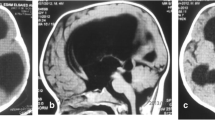Abstract
Objective
The objective was to report our positive experience of using dexamethasone to treat 13 patients with symptomatic slit ventricle syndrome (SVS).
Methods
Thirteen SVS patients who received dexamethasone during acute episodes were studied. The etiology for hydrocephalus was prematurity and intraventricular hemorrhage in 9 patients and neonatal meningitis, chorioamnionitis, Dandy–Walker variant, and congenital in 1 case each. The shunt was inserted at 1.8±1.0 months of age and SVS was diagnosed at 4.9±3.2 years of age.
Results
All patients reported relief and shorter duration of symptoms with dexamethasone. Surgical intervention was decided upon and carried out within 11±8 months of SVS diagnosis in 9 out of 13 patients. The other 4 are being monitored and continue to receive dexamethasone when needed.
Conclusions
Dexamethasone appears to be a useful treatment in acutely increased intracranial pressure caused by SVS. It can provide temporary relief during the decision-making process of whether and when to perform surgery.
Similar content being viewed by others
References
Abbott IR, Epstein FJ, Wisoff JH (1991) Chronic headaches associated with a functioning shunt: usefulness of pressure monitoring. Neurosurgery 28:72–77
Baskin JJ, Manwaring KH, Rekate HL (1998) Ventricular shunt removal: the ultimate treatment of the slit ventricle syndrome. J Neurosurg 88:478–484
Benzel EC, Reeves JD, Kesterson L, Hadden TA (1992) Slit ventricle syndrome in children: clinical presentation and treatment. Acta Neurochir (Wien) 117:7–14
Bruce DA, Weprin B (2001) The slit ventricle syndrome. Neurosurg Clin N Am 36:709–717
Buxton N, Punt J (1999) Subtemporal decompression: the treatment of noncompliant ventricle syndrome. Neurosurgery 44:513–519
Cohen SR, Dauser RC, Newman MH, Muraszko K (1993) Surgical techniques of cranial vault expansion for increases in intracranial pressure in older children. J Craniofac Surg 4:167–176
David LR, Taylor RG, Argenta LC (1996) A technique for cranial bone expansion. J Craniofac Surg 7:151–155
Di Rocco C (1994) Is the slit-ventricle syndrome always a slit-ventricle syndrome? Childs Nerv Syst 10:49–58
Epstein F, Lapras C, Wisoff JH (1988) “Slit-ventricle syndrome”: etiology and treatment. Pediatr Neurosci 14:5–10
Epstein FJ, Fleischer AS, Hochwald GM, Ransohoff J (1974) Subtemporal craniectomy for recurrent shunt obstruction secondary to small ventricles. J Neurosurg 41:29–31
Gil Z, Siomin V, Beni-Adani L, Ben Sira L, Constantini S (2002) Ventricular catheter placement in children with hydrocephalus and small ventricles: the use of a frameless neuronavigation system. Childs Nerv Syst 18:26–29
Guzelbag E, Ersahin Y, Mutluer S (1997) Cerebrospinal fluid shunt complications. Turk J Pediatr 39:363–371
Holness RO, Hoffman HJ, Hendrick EB (1979) Subtemporal decompression for the slit-ventricle syndrome after shunting in hydrocephalic children. Childs Brain 5:137–144
Ide T, Aoki N, Miki Y (1995) Slit ventricle syndrome successfully treated by lumboperitoneal shunt. Neurol Res 17:440–442
Jain H, Sgouros S, Walsh AR, Hockley AD (2000) The treatment of infantile hydrocephalus: “differential-pressure” or “flow-control valves”. A pilot study. Childs Nerv Syst 16:242–246
Le H, Yamini B, Frim DM (2002) Lumboperitoneal shunting as a treatment for slit ventricle syndrome. Pediatr Neurosurg 36:178–182
Major O, Fedoresak I, Sipos L, Hantos P, Konya E, Dobronyi I, Paraicz E (1994) Slit-ventricle syndrome in shunt operated children. Acta Neurochir (Wien) 127:69–72
Obana WG, Raskin NH, Cogen PH, Szymanski JA, Edwards MS (1990) Antimigraine treatment for slit ventricle syndrome. Neurosurgery 27:760–763
Oi S, Matsumoto S (1987) Infantile hydrocephalus and the slit ventricle syndrome in early infancy. Childs Nerv Syst 3:145–150
Rekate HL (1993) Classification of slit-ventricle syndromes using intracranial pressure monitoring. Pediatr Neurosurg 19:15–20
Acknowledgements
We thank Esther Eshkol for editorial assistance.
Author information
Authors and Affiliations
Corresponding author
Additional information
A commentary on this paper is available at http://dx.doi.org/10.1007/s00381-004-1133-x
Rights and permissions
About this article
Cite this article
Fattal-Valevski, A., Beni-Adani, L. & Constantini, S. Short-term dexamethasone treatment for symptomatic slit ventricle syndrome. Childs Nerv Syst 21, 981–984 (2005). https://doi.org/10.1007/s00381-004-1132-y
Received:
Published:
Issue Date:
DOI: https://doi.org/10.1007/s00381-004-1132-y




